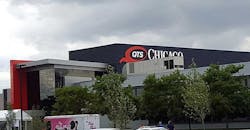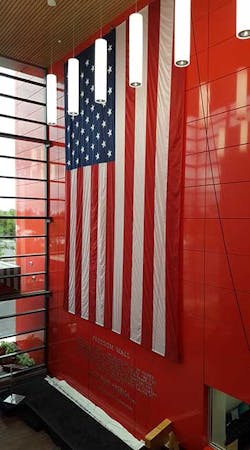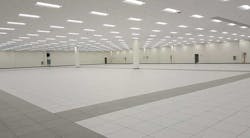CHICAGO – QTS Realty has become the master of the Internet-scale retrofit, finding former industrial facilities with sturdy infrastructure and transforming them into massive data centers.
This month QTS brought that formula to Chicago, opening a new data center in a former printing facility for the Chicago Sun-Times newspaper.
The project symbolizes the larger digital shift in the American economy, with servers and storage hardware replacing the printing presses and rolls of newsprint that once occupied the Sun-Times building. Instead of sending trucks loaded with newspapers into the streets of Chicago, the new tenants at QTS Chicago will send packets of data across a global network.
Data Center Frontier Special Report: The Chicago Data Center Market. Download It Now.
With its entry into the Chicago market, QTS adds new space in downtown, where data center supply has been constrained for some time. Data center space in downtown Chicago is concentrated in a handful of buildings, anchored by 350 East Cermak, the massive connectivity hub operated by Digital Realty Trust.
QTS offers up to 6 megawatts of space in the first phase of its project, with a potential buildout of 24 megawatts.
“We are encouraged by the demand we see in Chicago, which is one of the tightest Tier 1 data center markets in the United States,” said Chad Williams, the founder, chairman and CEO of QTS, noting that new development in Chicago has been limited over the past five years.. “We expect this data center to develop into one of the most interconnected facilities in our portfolio.”
Big Infrastructure, Low Cost
QTS Chicago also embodies the company’s approach to data center development. Located on a 30-acre piece of land nestled between Route 55 and the south branch of the Chicago River, the 317,000 square foot building exemplifies the retrofit model that has worked well for QTS.
“Chad is laser focused on getting a good building with good bones, and a good buy,” said Butch Goldi, Executive VP of Sales for QTS.
A huge American flag greets visitors to the QTS Chicago data center, which opened earlier this month. (Photo: Rich Miller)
QTS Realty Trust got its start in 2003 when the Quality Group of Companies purchased a data center in Overland Park, Kansas. QTS (Quality Technology Services) became an independent business in 2005 when it bought a large data center in Suwanee, Georgia. QTS has been growing ever since, and is currently expanding in seven geographic markets.
QTS now operates more than 1.28 million square feet of raised floor, has an additional 1.2 million square feet of powered shell space ready for rapid deployment of new raised floor capacity. The company also has lots of land attached to its data centers, which could allow it to add as much as 2.7 million additional square feet of raised floor space.
Williams says the ability to identify and acquire these “mega-scale” properties at a low cost basis is one of QTS Realty’s key differentiators.
The deal that set the company on its current course the 2006 acquisition of the Metro Technology Center in downtown Atlanta. The 990,000 square foot structure was built in 1954 by Sears to serve as the company’s primary distribution center for the Southeastern U.S., and later converted to mission-critical use by MetroNexus. QTS has converted it into a massive Internet-scale data center, which will eventually house more than half-million square feet of finished data center space.
Subsequent deals have followed this template:
- In Virginia, QTS acquired the former Qimonda semiconductor fabrication facility in a suburb of Richmond, buying the 1.3 million square foot campus for just $12 million in a bankruptcy court deal. The property included large existing amounts of raised floor space and chiller plants. QTS has converted the 210-acre campus into a data center housing federal IT clients, with a total of 110 MW of power capacity.
- In 2013, QTS bought a former Maxim semiconductor fab in the Dallas market, featuring a 700,000 square foot building on 40 acres of land. The facility, which has access to 140 megawatts of power, is being built out in phases. Tenants include a cloud provider that has leased 8 megawatts of IT capacity.
- In New Jersey, QTS has acquired existing data centers with tenants and revenue in place, but substantial expansion space. In 2014 it bought a McGraw-Hill data center in East Windsor with 180,000 square feet of shell space, with current tenants McGraw-Hill and Atos remaining in place.
- In June, QTS bought the DuPont Fabros NJ1 facility in Piscataway, retaining the tenants in Phase I while gaining another 180,000 square feet of expansion space. QTS paid $125 million to acquire a property where the initial developer had invested $250 million.
This strategy has helped QTS to a return on invested capital (ROIC) above 15 percent, better than many of its peers in the data center industry. Investors love these returns, which is why shares of QTS Realty Trust are up 28 percent in 2016, and have gained more than 160 percent since the company’s IPO in 2013.
How Mega-Scale Helps the Bottom Line
“We’ve built our platform over time by focusing on mega-scale infrastructure and being patient and opportunistic,” Williams said in the company’s most recent earnings call. He pointed to the company’s Richmond project as an example.
“Since opening the facility four years ago, we have brought on over 150,000 square feet of raised floor in service, supporting our acceleration in returns on capital,” said Williams.”Additionally, we still have over 400,000 square feet of remaining capacity to sell add incrementally higher returns in the future. We have seen the success of this strategy in Atlanta, and are now seeing it in Dallas now as well, and look forward to executing on our strategy in Chicago.”
The data hall in Phase I of the QTS Chicago data center. (Photo: Rich Miller)
The first phase of QTS Chicago features a single 14,000 square foot data hall, which it expects to be filling with colocation customers. QTS offers a range of services, including wholesale space (36 percent of revenue), retail colocation (45 percent), and cloud services and managed hosting (19 percent). QTS has the capacity to pursue large footprint deals (it recently signed an 8 megawatt tenant in Dallas), but believes Chicago sales will be focused on colo.
“We see a huge demand for cages and cabinets,” said Goldi. “We’re pretty sure we’ll give all our competition (in Chicago) a run in the cage and cabinet space.”
Services Provide Upside
“Colocation remains the engine of our business,” said Williams, who added that the acquisition of Carpathia Hosting last year has strengthened the company’s ability to sell managed services to these colo customers. “It is apparent that our strength in services has grown with the (Carpathia) integration.”
The first data hall in Chicago can be quickly expanded to 48,000 square feet, QTS says. The data halls are on the ground floor of the facility, which housed the Sun-Times’ printing press. UPS rooms and cooling infrastructure are housed on a second-floor “power spine” that runs the length of the building. This upper level once housed huge rolls of newsprint, which were fed to the presses through openings in the floor.
QTS can build up to 133,000 square feet of raised-floor in the current configuration. It is exploring plans to add a mezzanine level that will create space for an additional data hall.
The property has 30 acres of land, offering QTS the ability to add a second building with an additional 213,000 square feet of raised floor and 32 megawatts of power, giving it an upside of 346,000 square feet of raised floor and 56 megawatts of power within the campus.
“We will have the scale and opportunity on this campus to do great things across all of our products,” said Williams. “Chicago is a market we are very excited about. We remain confident we have the right asset in the right market at the right time, and that Chicago will be a great success for our business for the years to come.”
For more insights into the Chicago market, download the new Data Center Frontier Special Report: The Chicago Data Center Market.









